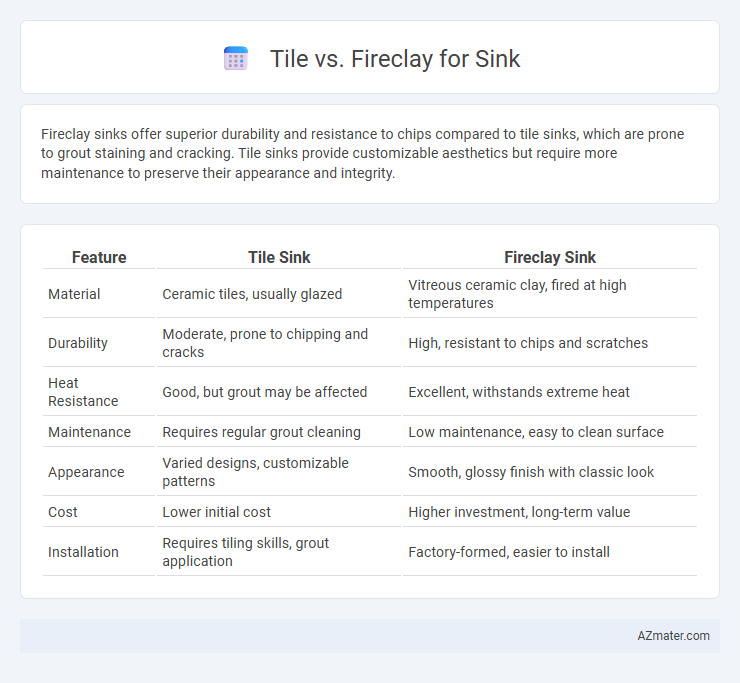Fireclay sinks offer superior durability and resistance to chips compared to tile sinks, which are prone to grout staining and cracking. Tile sinks provide customizable aesthetics but require more maintenance to preserve their appearance and integrity.
Table of Comparison
| Feature | Tile Sink | Fireclay Sink |
|---|---|---|
| Material | Ceramic tiles, usually glazed | Vitreous ceramic clay, fired at high temperatures |
| Durability | Moderate, prone to chipping and cracks | High, resistant to chips and scratches |
| Heat Resistance | Good, but grout may be affected | Excellent, withstands extreme heat |
| Maintenance | Requires regular grout cleaning | Low maintenance, easy to clean surface |
| Appearance | Varied designs, customizable patterns | Smooth, glossy finish with classic look |
| Cost | Lower initial cost | Higher investment, long-term value |
| Installation | Requires tiling skills, grout application | Factory-formed, easier to install |
Introduction: Tile vs Fireclay Sinks
Tile and fireclay sinks offer distinct advantages for kitchen and bathroom use, with tile sinks providing customizable design options through varied colors and patterns, while fireclay sinks are known for their durability and smooth, non-porous surface that resists stains and scratches. Fireclay sinks are crafted from molded ceramic with a high-gloss glaze, making them ideal for heavy-duty use and easy maintenance. Tile sinks, composed of individual ceramic or porcelain tiles, allow for creative styles but may require more upkeep due to grout lines prone to staining and cracking.
Material Composition and Manufacturing Process
Tile sinks are typically made from ceramic or porcelain clay fired at high temperatures to achieve a durable, glazed surface resistant to stains and heat. Fireclay sinks are crafted from a mixture of clay and glaze materials that are fired at even higher temperatures, resulting in a denser, non-porous, and chip-resistant finish. The manufacturing process of fireclay involves more rigorous molding and firing techniques, which enhance its strength and longevity compared to traditional tile sinks.
Durability and Longevity Comparison
Fireclay sinks offer superior durability due to their dense, vitrified ceramic composition that resists chipping, scratching, and staining better than tile sinks, which are prone to grout deterioration and individual tile cracking over time. The non-porous surface of fireclay ensures long-lasting resistance to bacteria and easy maintenance, extending its lifespan significantly beyond tiled counterparts, which often require periodic grout replacement and sealing. In terms of longevity, fireclay sinks typically last several decades with minimal wear, while tile sinks may suffer from grout discoloration and tile loosening, reducing their long-term structural integrity.
Design Versatility and Aesthetic Appeal
Tile sinks offer extensive design versatility with an array of colors, patterns, and textures, allowing for highly customized and intricate kitchen or bathroom aesthetics. Fireclay sinks provide a smooth, glossy finish that exudes timeless elegance and durability, often available in classic white or subtle hues suited for traditional and modern interiors. The choice between tile and fireclay sinks balances the opportunity for artistic expression against the desire for a sleek, uniform look with enduring appeal.
Installation Process and Requirements
Tile sinks require meticulous grout application and waterproofing during installation to prevent water damage, making the process labor-intensive and time-consuming. Fireclay sinks come pre-formed, allowing straightforward undermount or drop-in installation without the need for sealing individual joints, reducing the risk of leaks and simplifying maintenance. Both materials demand sturdy support structures, but fireclay's durability and uniform surface make it less prone to cracking during installation compared to tile.
Maintenance and Cleaning Needs
Fireclay sinks boast a non-porous, glazed surface that resists stains and scratches, making maintenance simple with just mild soap and a soft cloth. Tile sinks, constructed from multiple grout-lined pieces, require regular grout cleaning to prevent mold and mildew buildup, increasing maintenance efforts. Fireclay's seamless design reduces cleaning challenges, while tile sinks demand more frequent grout sealing and scrubbing to maintain hygiene and appearance.
Resistance to Stains, Scratches, and Heat
Fireclay sinks demonstrate superior resistance to stains, scratches, and heat due to their dense, vitrified ceramic composition that withstands daily wear and high temperatures without discoloration. Tile sinks, while customizable and aesthetically versatile, often feature grout lines that are prone to staining and can be more susceptible to scratches and thermal damage over time. Choosing fireclay ensures a durable, easy-to-maintain surface ideal for kitchens with heavy use and exposure to hot cookware.
Cost Differences and Value for Money
Tile sinks generally have a lower upfront cost, with prices ranging from $30 to $100 per square foot, making them budget-friendly for homeowners. Fireclay sinks, priced between $300 and $800, offer superior durability and resistance to stains and scratches, contributing to long-term value despite higher initial expenses. Considering lifespan and maintenance, fireclay provides better value for money due to its robustness and low upkeep compared to the more porous and easily chipped tile surfaces.
Environmental Impact and Sustainability
Fireclay sinks are highly durable and made from natural clay fired at extreme temperatures, resulting in a non-toxic, long-lasting product with minimal waste during manufacturing. Tile sinks, often composed of ceramic or porcelain, may involve higher environmental costs due to glaze use and more frequent replacement from chipping or cracking. Choosing fireclay enhances sustainability through reduced resource consumption and longer lifecycle, making it a more eco-friendly option compared to tile sinks.
Which Sink Material is Best for You?
Tile sinks offer customizable designs and are highly resistant to heat and stains, making them ideal for decorative kitchens and heavy use. Fireclay sinks provide exceptional durability, resistance to scratches, chips, and stains, and feature a smooth, non-porous surface that remains easy to clean. Choosing between tile and fireclay depends on your priorities for aesthetics, maintenance, and long-term durability in the kitchen environment.

Infographic: Tile vs Fireclay for Sink
 azmater.com
azmater.com